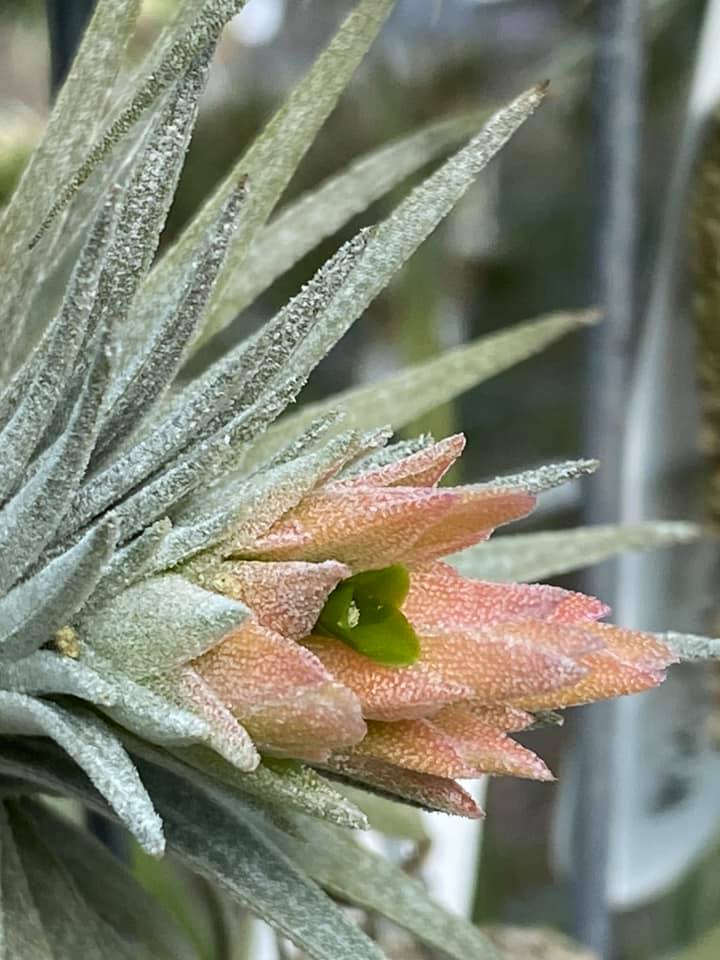


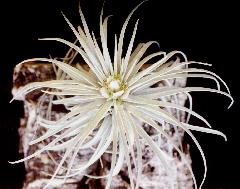
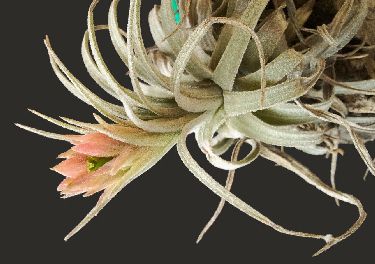
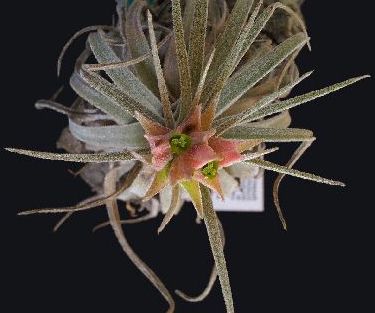
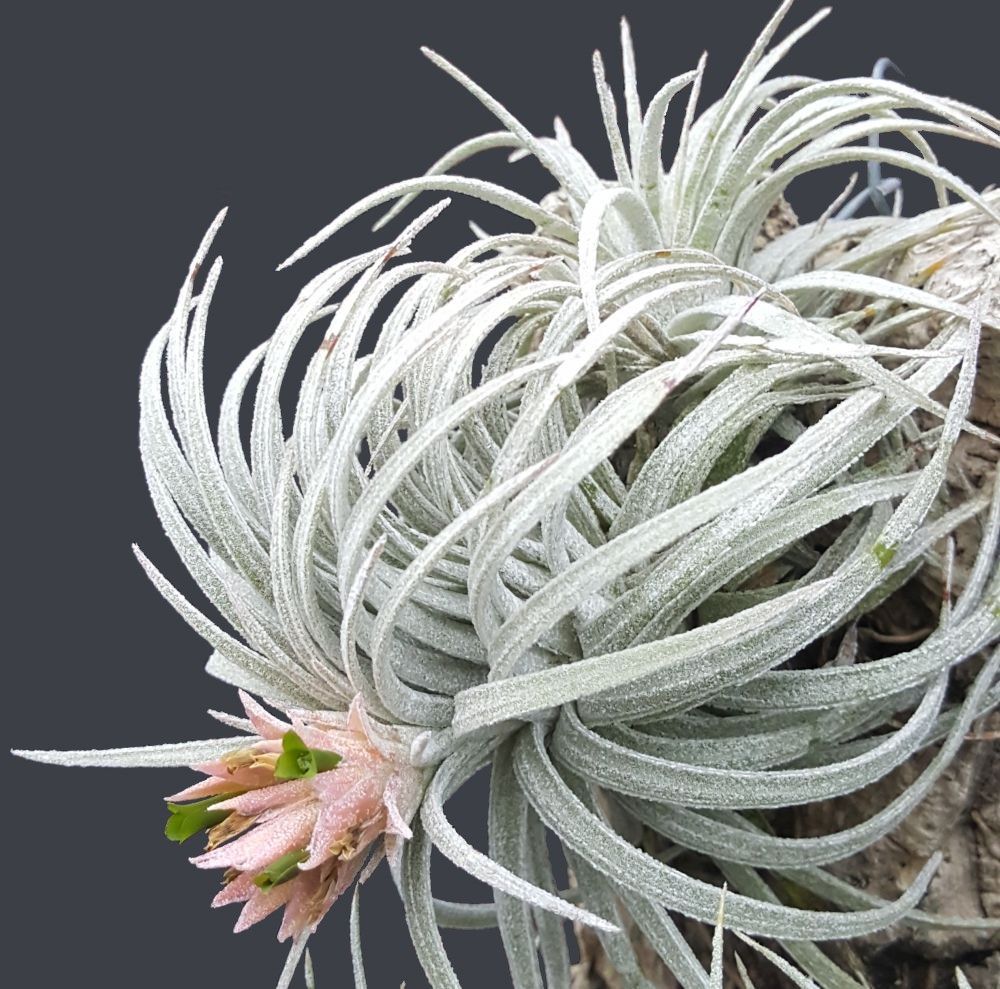


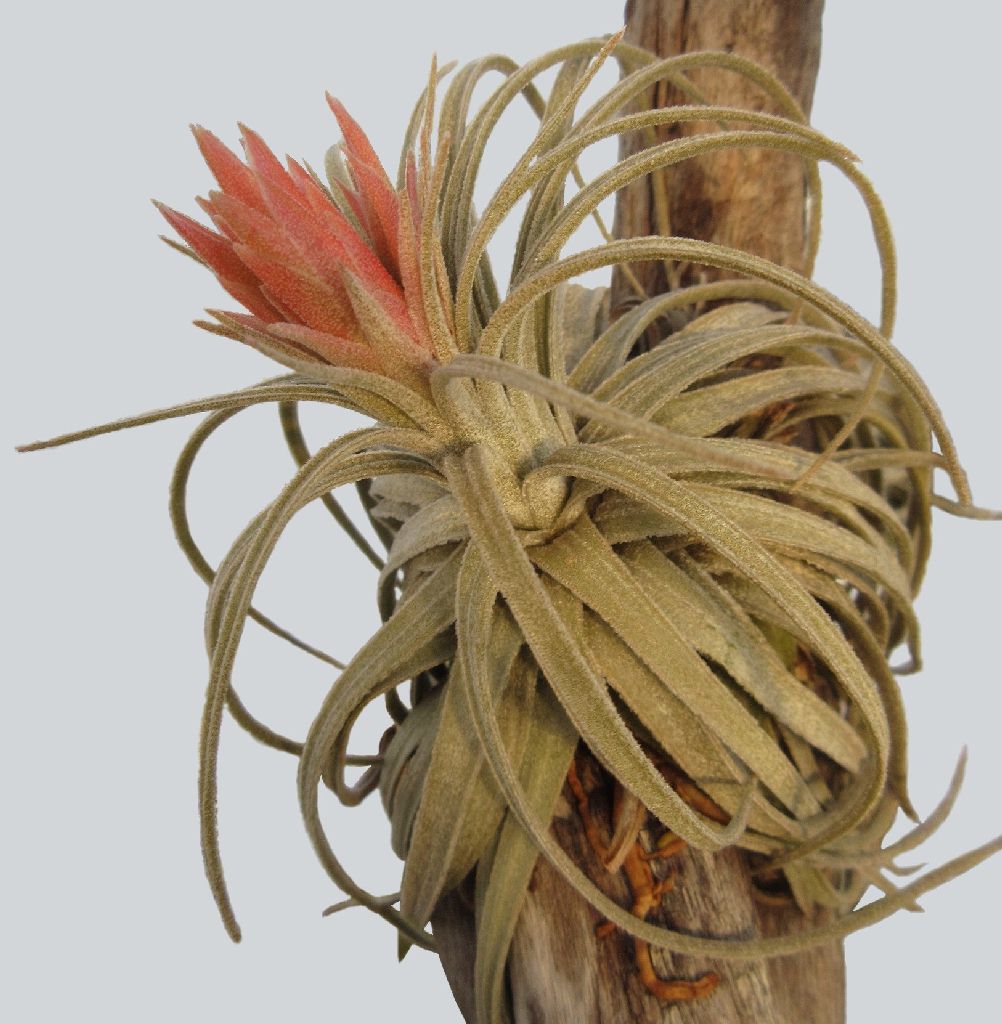
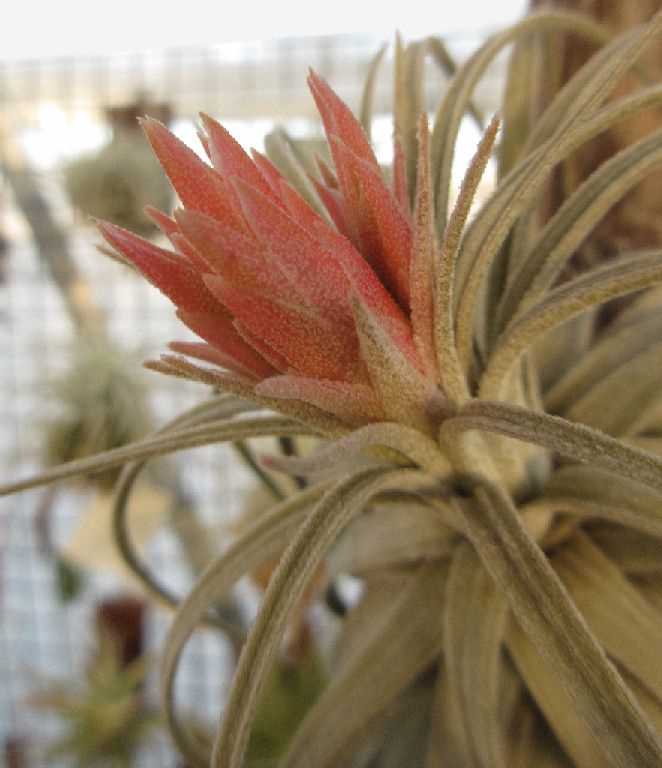
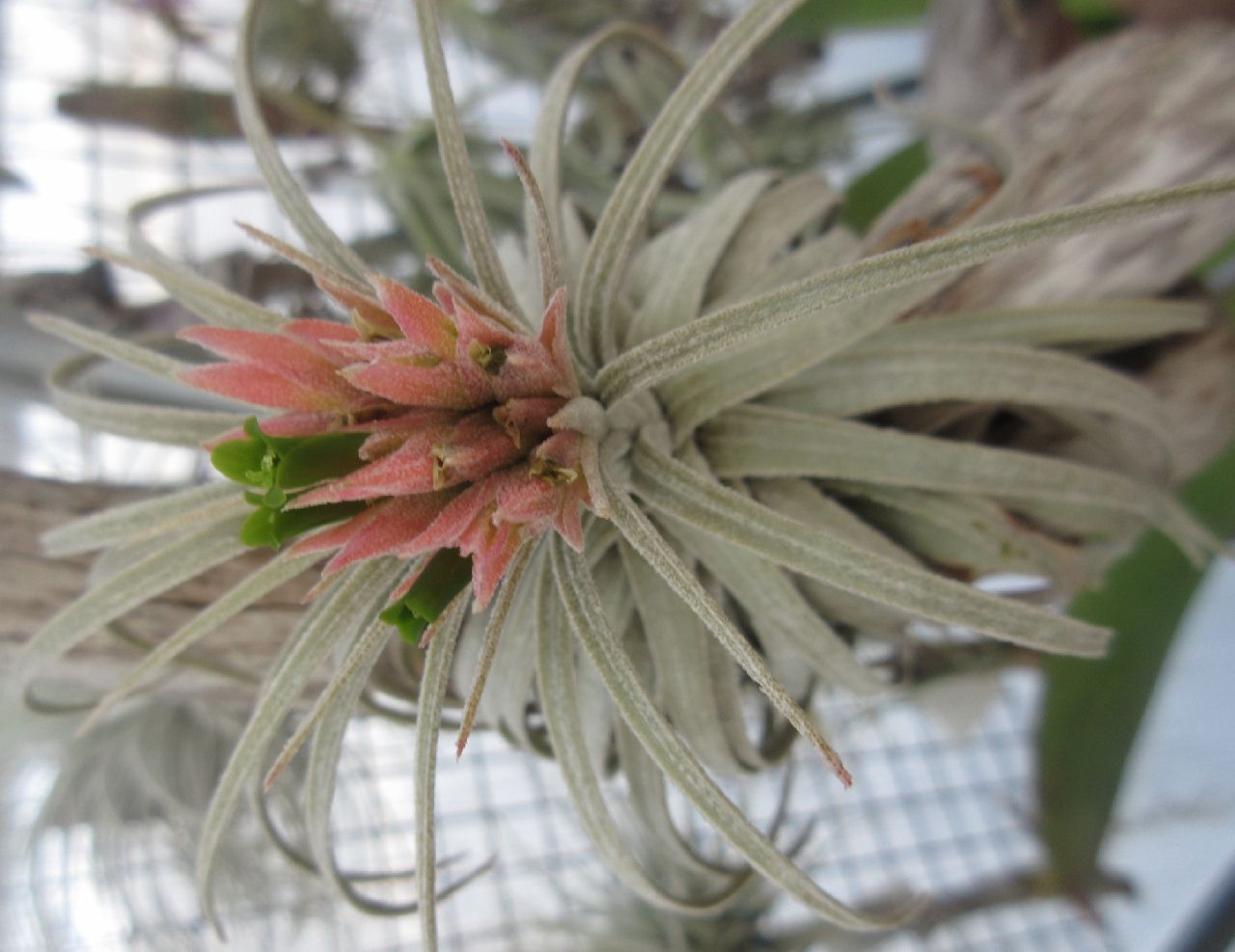
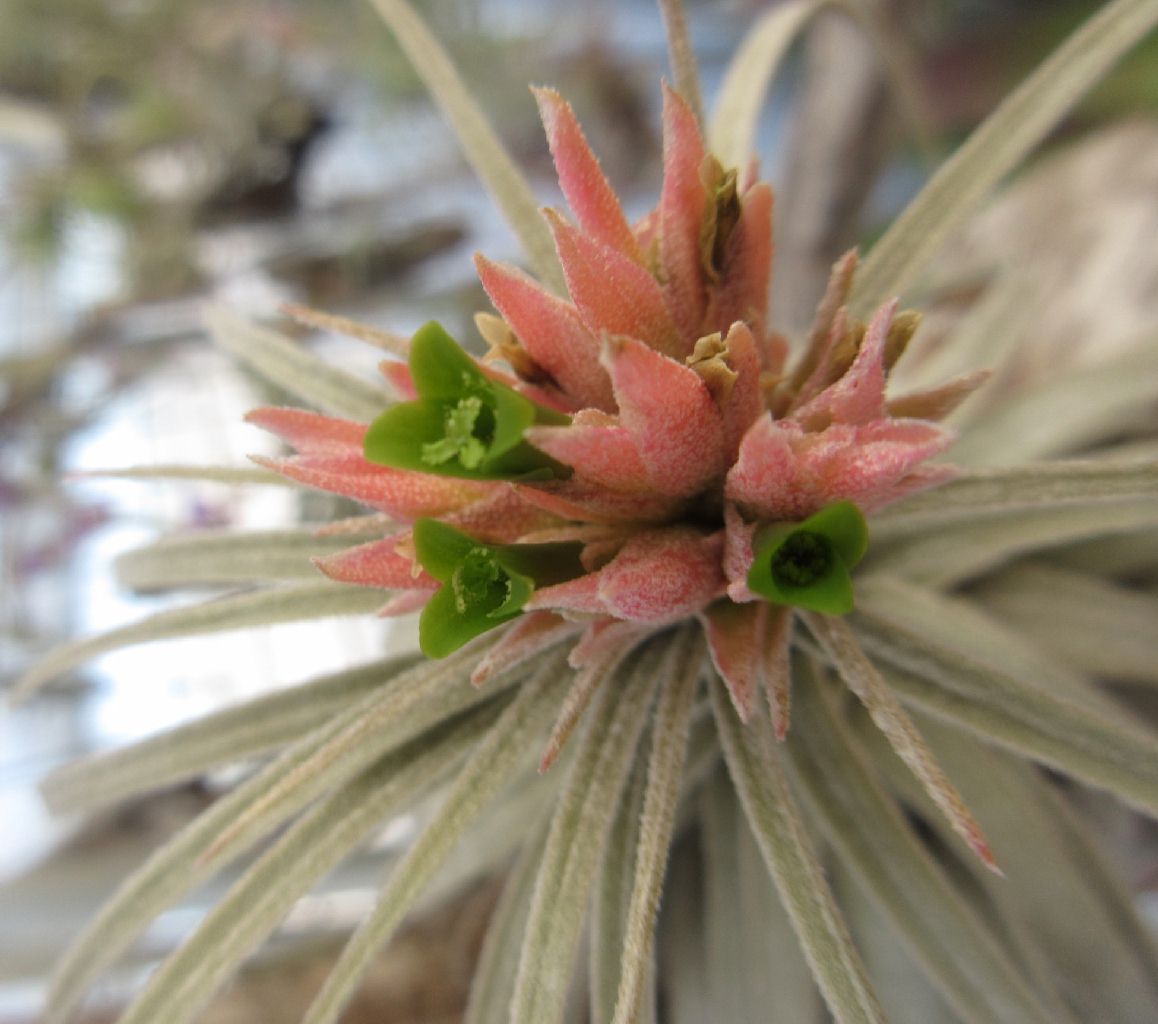
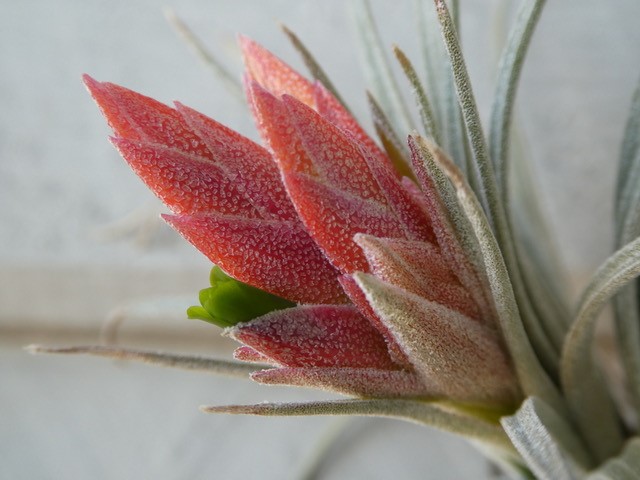
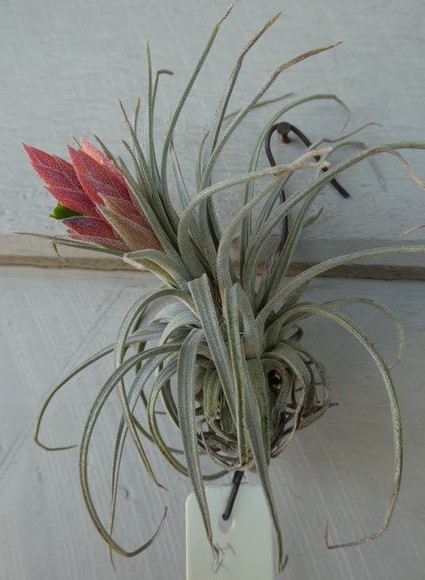
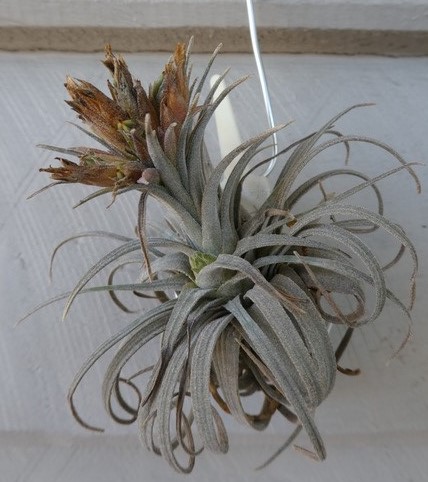
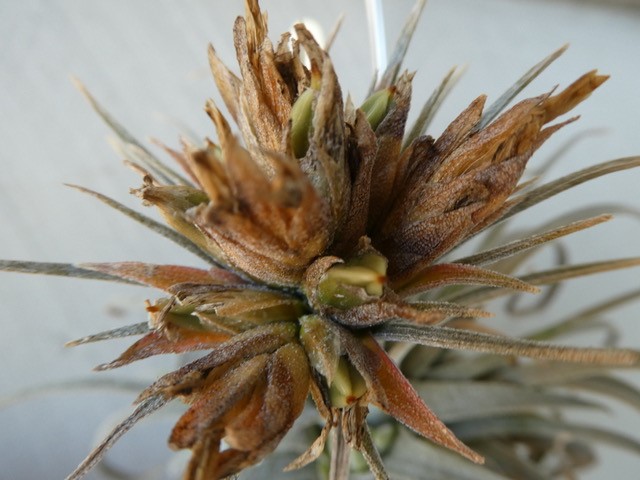



Comment: Espejo-Serna (2002) states that Tillandsia mauryana has black anthers. Also in his key of the species, he gives this as a characteristic of Tillandsia mauryana. According to my examinations, the anthers were yellow olive at the time of anthesis and olive brown postfloral. Also herbarium material showed only brown anthers.
Species name. The plant was named after the Mexican botanist P. Maury.
Habitat and Range. Tillandsia mauryana is proven only for the north of Mexico (State of Hidalgo). The type location is in Venados valley near Metztitlan. There, the type grows with cacti on steep rock-walls. Other Tillandsias growing there seem to be deviant forms of Tillandsia fasciculata Sw. 1788 and T. juncea, Ruiz & Pav., Poir., 1817, which necessitates even further research and observation.
Moreover, there is a further habitat of T. mauryana near Tolontongo, also growing on steep rock-walls above the river valley. The plants always grow at steep rock-walls. Epiphytic growing examples could never be observed.
Beyond these two locations, we could only discover one another location, in Hidalgo too: at Aguas Magicas del Vite, at 2000 m, near San Regla. There we could find only limited numbers of plants.
Cultivation. Tillandsia mauryana is undemanding in cultivation. It can be kept outside in summer without any difficulty.
Examined material. Hidalgo: Metztilan, Marz 1979, K. & R. Ehlers s.n. (WU); Metztitlan, 1300 m, 10.3.1990, K & R. Ehlers EM900101 (WU); Metztitlan, 1400m, Ehlers, EM000301 (WU); Metztitlan-San Cristobal, 1500m, 20.11.2003, Ehlers EM000302 (WU); Tolontongo 1800m, 22.3.1994, K. & R. Ehlers EM942705 (WU); Tolontongo, 1250m, Ehlers EM061801 (WU); Tolontongo, 1998, L. Kohres s.n. (WU); Aguas magicas del Vite, 2000m, 23.2.03, Jurgen Lautner EM032203.
Tillandsia mauryana L.B.Sm. forma secundifolia Ehlers, Die Brom Sonderheft 6: 56-60. 2009
A forma typica foliis secundis differt.
Type: Mexico, Estado Hidalgo, Metztitlan,l300m, 12.2.1992, J Lautner L92/3 (holo MEXU).
Paratype: Estado Hidalgo, prope Tolontongo, 1900m, 22.2.2006, R. Ehlers & M.Kretz EM061802 (WU).
This form of Tillandsia mauryana is very strikingly different. It should be described as a new form.
Species name. The name of the form refers to its claw-like and one-sided bending of the leaves (secund), thereby differing from the Type.
Habitat and Range. There are some rock-walls, at which this claw-like form grows in large numbers, however always at separate locations from Tillandsia mauryana var. mauryana. Associated occurrences with the normal form of Tillandsia mauryana could never be determined.
The origins of herbarium material stated in the literature for Tillandsia mauryana are to some extent (US) doubtful, particularly (U.S.) Smith (1937) and Espejo (2002) quote a herbarium specimen: Foster & van Hyning 2910, March 30, 1957, Puebla, 30km close to Rio Frio. A number of botanists, many friends of mine and also I have been to this area many times, the normal transit region for travelling into the southern part of Mexico. Today there is an old road that winds up to the plateau at Rio Frio, as well as a much used highway. Along both roads, I have already often explored the terrain.
The area around Rio Frio lies over 3000m high and there is often snow in wintertime. It is quite funny when the Mexicans build small snowmen on their cars and drive into Mexico City where they are very much marveled at. Fog often prevails there and repeated signs on the roadsides warn of this: Niebla! It is a large forest area, where beautiful, large specimens of Tillandsia macdougallii L.B.Smith grow on the pine trees. If one is lucky, one can also find T. andrieuxii L.B. Smith. Now and then, the forest is interrupted by flat, grassy plains, pastures or cornfields. But there are never rocks, where one would expect to find Tillandsia mauryana. It seems therefore ecologically unlikely that Tillandsia mauryana grows there.
A further specimen from Jalisco is cited by Smith (1977) and also by Espejo (2002):
Mezquitic, 16.4-1951. McVaugh (1989) however questions linking this plant to Tillandsia mauryana. My opinion to this plant is as follows: It is really not Tillandsia mauryana but a new species T. grandispica spec. nov., described in this publication together with the comments of Mc Vaugh. In Jalisco near Mezquitic on the way to Monte Escobedo I have found plants corresponding exactly the specifications of Mc Vaugh, which are cited in the description of Tillandsia grandispica.
Cultivation. The cultivation does not differ from Tillandsia mauryana var. mauryana.
Tillandsia mauryana L.B. Smith, Contributions from the Gray herbarium 117:31, pl. 31, figs. 32-3. 1937. See also Flora Neotropica Monograph 14 Part 2:752-4.
Tillandsia atroviridipetala sensu L. B. Smith, Phytologia 7: 173, 1960, non Matuda, 1957.
Plant usually a lithophyte, nearly stemless to short caulescent, 5-12cm tall, usually single, rarely tightly clustering; roots 1-2mm in diameter, brown.
Leaves very densely arranged, all but the centermost tightly recurving (the centermost leaves often stiffly erect), 60 to 80 in number, silver-grey to silver, usually forming a spherical rosette.
Leaf sheaths broadly elliptic, 8-20mm wide, thick, pale green or tan but densely white lepidote except at the extreme base.
Leaf blades very narrowly triangular, subulate, acute, 5-10cm long, 5-8mm wide, 1-2mm thick, succulent, brittle, very slightly channeled, keeled or ribbed, very densely covered with coarse spreading white trichomes and appearing slightly rough or pruinose. Scape very short, concealed within the leafy rosette.
Scape bracts like the leaves.
Inflorescence compound, very densely digitate with 2 to 6 branches.
Primary bracts elliptic, shorter than the branches, densely white lepidote.
Branches of the inflorescence erect to slightly spreading, 1-3cm long, 2-to 6-flowered.
Floral bracts tightly imbricate, ovate, acute, 12-25mm long, carinate, green, yellow or orange but densely white lepidote.
Flowers lasting 1 to 3 days.
Sepals lanceolate, acute, 12-15mm long, green but densely white lepidote.
Corolla spreading.
Petals very narrowly lanceolate, 15-23mm long, green.
Stamens and style included.
DISTRIBUTION. Native in Mexico, in the States of Hidalgo and Puebla, on steep, dry cliffs at elevations of 1500-2700m.
STATUS IN HORTICULTURE. Not common in cultivation.
VEGETATIVELY RESEMBLES:
Tillandsia atroviridipetala Matuda which is smaller with nearly filiform leaf blades only 1-4mm wide and more ciliate appearing trichomes;
T. ionantha Planchon (odd forms) which has fewer, more erect, narrower leaf blades which are less silver and frequently tinged red.
Tillandsia mauryana L. B. Smith, Contr. Gray Herb. II. 117: 31. pl. 2, figs. 32, 33. 1937. by McVaugh in Flora Novo-Galiciana 78. 1989
Cited by Smith (in Smith & Downs, 1977), on the basis of McVaugh 12020, from dry steep canyons in deciduous forest of arborescent Ipomoea, east of Mezquitic, Jai., at an elevation of ca 1800m. The specimen, collected in mid-April, is from an over-mature fruiting plant; the capsules have opened and the valves have separated but are loosely held in the rosette of bracts. The species was known to Smith additionally from a single locality in Puebla and from two collections in the type-region in Hidalgo (Canada de Metztitlan, Maury 5747, GH!, the holotype).
In the original material of T. mauryana the plants are small, with very numerous recurving leaves in a dense rosette; leaves 7-8cm long, densely and coarsely "spreading-lepidote"; blades are described as narrowly triangular, attenuate, 7mm wide; scape "very short" with foliaceous recurving bracts; inflorescence densely digitate from 3-5 spikes; spikes 3cm long, 1cm wide, flattened, densely 6-flowered; floral bracts 13mm long, carinate, bearing coarse cinereous spreading scales; sepals lanceolate, 12mm long; petals 14mm long, yellow-green when dry; stamens and pistil included; fruit not described.
In the plant from Mezquitic the crowded rosette of leaves is like that described for T. mauryana, but the blades are scarcely 5mm wide; the leaf-scales superficially appear irregularly bowlshaped, with broad thin suberect lobed margins; the scape is so short that the fruits seem to arise in a cluster from the rosette; the fruits are ca 4cm long; the flowers were very crowded, perhaps about 20, but I cannot discern what the flower morphology may have been, nor that of the inflorescence; according to a note on the specimen by Smith, the floral bracts are carinate, and the sepals "large, 19mm long."
Epiphytic species of Tillandsia are few in the high ridge-and-barranca country around Mezquitic, and it should be possible to find additional flowering and fruiting material of this particular plant during the autumn and winter months. Superficially the plant resembles T. magnusiana Wittm. and T. plumosa Baker, which are known from several localities in the mountains of Jalisco, but in those species the foliar scales have narrow sharp erect points that make the herbage appear bristly.
Note that Ehlers considers McVaugh 12020 to be the same as her T. grandispica.
Viridantha secundifolia (Ehlers) Hern.-Cárdenas, Espejo & López-Ferr., comb. et stat. nov. Phytokeys 132: 99-110. 2019
Basionym. Tillandsia mauryana L.B. Sm. forma secundifolia Ehlers, Die Bromelie. Sonderheft 6: 56–60. Figs pp. 56, 57, 60. 2009.
Type. MEXICO. Hidalgo: Metztitlán, 1300 m a.s.l., 12 February 1992, J. Lautner L92/3 (holotype: MEXU not found); Hidalgo, prope Tolantongo “Tolontogo”, 1900 m a.s.l., 22 February 2006, R. Ehlers & M. Kretz EM061802 (paratype: WU not found). Lectotype (here designated): figure page 56, Die Bromelie. Sonderheft 6: 56-60. 2009.
Description.
Plants saxicolous, flowering 10–13 cm tall, 12–14 cm diameter; rosettes acaulescent, solitary or caespitose, falcate in outline.
Leaves numerous, longer than the inflorescence;
sheaths pale brown on both surfaces, broadly oblong to nearly square, 1–1.2 cm long, 0.8–1.1 cm wide, glabrous towards the base on both surfaces;
blades falcate, densely white-greyish lepidote, narrowly triangular, 4.5–7 cm long, 0.5– 0.8 cm wide, apical portion long attenuate.
Inflorescence short pedunculated, falcate, one-branched, with 3–5 spikes;
peduncle 1–1.5 cm long, 3–5 mm diameter, covered by the peduncle bracts;
peduncle bracts similar to the leaves but reducing in size towards the apical portion, densely white-greyish lepidote;
spikes reddish-rose, erect and appressed, flattened, elliptic, 2.5–3.5 cm long, 1–1.5 cm wide;
flowers distichous, erect and appressed, 3–5 by spike;
floral bracts reddish-rose at the apex, yellowish-green towards the base, ovate, 1.8–2 cm long, 0.7–1.2 cm wide, apex acute to acuminate, ecarinate to slightly carinate at the apex, lepidote abaxially;
sepals pale green, lanceolate, 1.2–1.5 cm long, 0.3–0.4 cm wide, apex acute, the two adaxial ones carinate, lepidote abaxially;
petals dark green, narrowly oblong, 2–2.5 cm long, 0.25–0.3 cm wide, apex rounded to obtuse;
filaments white, 1.4–1.6 cm long;
anthers pale to dark green, 2.5–3 mm long;
ovary broadly ovoid, 3.5–4.5 mm long, 2.5–3.5 mm diameter;
style white, 6–10 mm long, included; style branches green.
Capsules 1.5–1.8 cm long, 5–8 mm diameter;
seeds fusiform, 3–4 mm long, coma 0.8–1.2 cm long.
Habitat and ecology. Viridantha secundifolia is only known from the state of Hidalgo in the western and eastern regions of Metztitlán and Tolantongo municipalities, respectively, where it grows on vertical walls in xerophilous scrubs at elevations between 1100 and 1900 m a.s.l.
Phenology. Blooming in January and February.
Observations. Tillandsia mauryana was described by Lyman B. Smith (1937), based on specimens from the canyon of Metztitlán, in the state of Hidalgo, Mexico. Espejo-Serna (2002) transferred the species to Viridantha. Ehlers (2009) described T. mauryana L. B. Sm. forma secundifolia, differentiating it from the typical form only by the secund disposition of its leaves. Besides, Ehlers (2009) mentioned that its populations grow separated from those of T. mauryana. The detailed analysis of the morphological characteristics of living and dried specimens of T. mauryana forma mauryana and T. mauryana forma secundifolia allowed us to detect that, in addition to the characteristic mentioned by Ehlers (2009), there are other differences in the plants of both populations such as: the shape of the rosettes (falcate vs. spherical); the length (1–1.2 cm vs. 1.5–2.5 cm) and the shape (broadly oblong to square vs. broadly elliptic) of the leaf sheaths; the length of the floral bracts (1.8–2 cm vs. 1–1.5 cm), the presence or not of a keel on the floral bracts (absent or visible only in the apex vs. present along the bract); and the colour of the anthers (pale to dark green vs. black).
Viridantha grandispica (Ehlers) Hern.-Cárdenas, Espejo & López-Ferr., V. rzedowskiana Hern.-Cárdenas, Espejo & López-Ferr. and V. teloloapanensis (Ehlers & Lautner) Hern.-Cárdenas, Espejo & López-Ferr., are other species morphologically similar to V. secundifolia (Table 1). Viridantha secundifolia differs from V. grandispica in the shape of the rosettes (falcate vs. spherical); in the shape of the leaf sheaths (broadly oblong to square vs. narrowly oblong); in the presence or not of a keel on the floral bract (absent or visible only in the apex vs. present along the bract); and in the shape of the sepals (lanceolate vs. ovate).
Viridantha secundifolia differs from V. rzedowskiana in the shape of the rosettes (falcate vs. spherical); in the size of the leaf sheaths (1–1.2 cm × 0.8–1.1 cm vs. 1.8–2 cm × 1.5–1.7 cm); in the keel of the floral bract (absent or visible only in the apex vs. present along the bract); and in the shape of the sepals (lanceolate vs. ovate).
Viridantha secundifolia differs from V. teloloapanensis in the shape of the rosettes (falcate vs. spherical); in the shape of the leaf sheaths (broadly oblong to square vs. ovate); in the number of the spikes (3–5 vs. 1); and in the shape of the sepals (lanceolate vs. ovate). So we concluded that T. mauryana forma secundifolia presents different and consistent morphological characteristics to those observed on the typical form and can be considered as a distinct species.
Specimen examined. MEXICO, Hidalgo: municipio de Metztitlán. 28 km sobre el camino que va de Metztitlán a Tolantongo (20°35'43"N, 98°54'09.9"W), 1103 m a.s.l., 3 February 2018, R. Hernández-Cárdenas y A. Sarabia 2136 (UAMIZ).